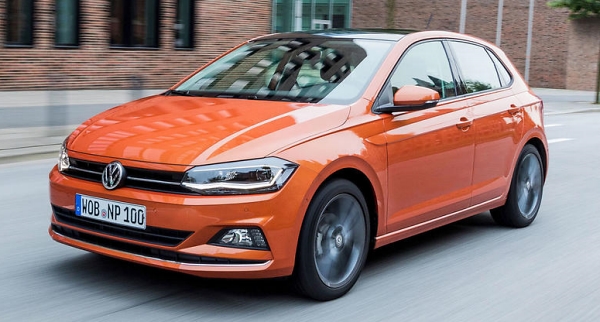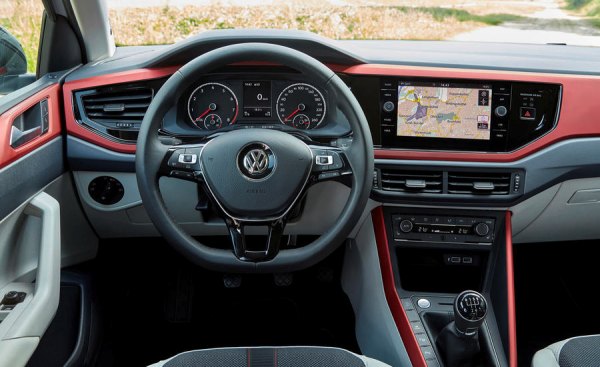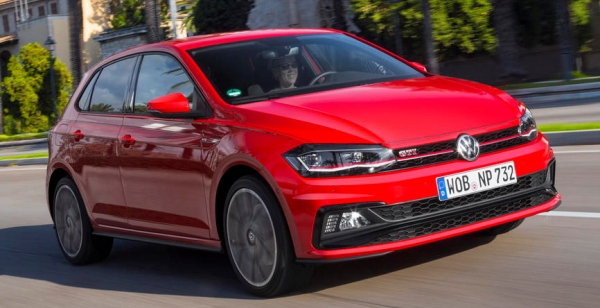Published
on 23
Sep 2017
|
All rights reserved.
|
|
|

|
|
New
Polo has to beat not only Ford Fiesta, but also its twin sister, Seat
Ibiza.
|
|
Volkswagen sold 14 million
Polos in 5 generations during the past 42 years. That might be less
than half the number of Golf sold in the same period, but it is still
one of the most important
cars of the group. Last year, some 800,000 Polos found buyers globally,
placing it at the top of the B-segment supermini chart. Entering the
6th generation, I suppose it could easily retain its sales crown.
However, whether the new Polo is really the best of the class is worth
debating. As we know, the latest Ford Fiesta is a great supermini,
improving quality and refinement a lot without denting its
class-leading
dynamics. Seat Ibiza is also a 5-star contender, and probably the
most worrying to Volkswagen's salespersons, as it shares a lot of genes
with the new Polo yet is cheaper to buy.
Yes, both Ibiza and Polo sit on the group’s MQB A0 platform, which is a
derivative of the original MQB introduced by Golf 7. Compared with the
Golf, this version uses a shorter and narrower floorpan as well as
lighter suspension and other components to reflect its lower kerb
weight and power. Unsurprisingly, the Golf’s
multi-link rear axle gives way to a simple torsion beam as in all
B-segment cars bar Mini, so to save money and extract a bit more boot
space. While Golf is offered with electronic adaptive dampers, its
smaller sister makes do with 2-mode switchable but non-adaptive
dampers.
 |
|
Polo
and Ibiza are not a world apart, but more like a village apart.
|
|
The Polo and Ibiza are actually twins in different clothes. They are
separated by just 6mm in length, and their wheelbase are identical at
2564mm, which is long by class standard. The Ibiza is a bit wider,
thanks to its broader shoulders, but interior space is virtually the
same. The Polo's rear bench is truly good for two adults, thanks to the
longer wheelbase and a flat roof line that adds 30mm rear headroom. By
deleting the spare tire, the Volkswagen affords a generous 351 liters
of luggage space, significantly more than Ibiza as well as Fiesta. This
is one of the most accommodative cars in the supermini segment,
although you might question the definition of “supermini” these days –
it is just as large as a Golf Mk3!
Even the clothes are difficult to separate the twins. When Ferdinand
Piech was in charge, Volkswagen group used different styling direction
and different quality levels to distinguish the brands employing common
platforms. For instance, the 2001
Seat Ibiza adopted a round theme while the 2001 VW Polo employed a square body.
The Polo was also higher in material grade, fit and finish and
insulation. Nowadays the group is liberating the control of its
subsidiaries and allows them to take vital decisions on strategies. The
Spanish division no longer lives under the shadow of the German core
brand. That is why we found the new Ibiza has upgraded so much in build
quality. More unfortunate to VW, both brands favour a crisped and
angular design approach, and this make the two cars look very close in
profile. What distinguish them are detailed surface treatment – the
Seat is more straightforward, more like folding paper, while the
Volkswagen has subtler surface treatment at edges and corners.
Unsurprisingly, the nose and grille design of Polo has strong family
resemblance to Golf, and this helps raising its image above the Spanish
car. The rear end is typical no-nonsence/boring school of Volkswagen.
Which car looks more attractive? It depends on your taste. Seat is more
expressive, while VW is more restrained. However, when you step back
and look at everything else in the class, e.g. Fiesta, Corsa, 208,
Clio, C3, Jazz, Micra, i20, Rio, Mazda2, Swift… you will find the Polo
and Ibiza are not a world apart, but more like a village apart.

|
|
Cabin quality
is still above Ford, but the gap from Seat is virtually non-existent.
|
|
Much the same can be said to its interior. Well, the design of
Volkswagen is certainly different. It employs a customizable
color-coded dash panel (which matches the seat fabrics as well) for a
more colorful life than the dark, cooled theme of Ibiza. The dashboard
layout is also different, with the touchscreen located higher at the
center console, above the air vents. Rivals like Ford, Peugeot and
Mazda have their screens mounted higher still, but compared with Ibiza
the Polo’s touchscreen is certainly more ergonomically sounded, easier
to see and to touch. The latest infotainment system on VW is also
superior, being responsive, clear and intuitive to control, which means
it is the class best. Besides, on the VW you can opt for an Audi
TT-style full TFT instrument which doubles as the display of sat nav
map, although it is not quite as high resolution or clear because it is
cheaper. The German car still offers classier electronic technology.
Nevertheless, the Polo no longer leads in build quality. Earlier this
year, we were amazed by how soft the plastics, how slick the controls
and how tight the assembly gaps on the Ibiza’s interior. We expected
its Volkswagen sister to take another leap again, but disappointingly,
it is no better than the Seat. While key surfaces that are most
frequently touched are soft-touch plastics, the hard, cheaper plastics
at lower level, the transmission tunnel and the entire door panels are
just the same as most other rivals. It is still above Ford Fiesta in
cabin quality, but the gap from its sister is virtually non-existent.
In fact, the interior design and black theme of Seat feels more
tasteful in my eyes.
The range of engines offered by VW is also the same as Seat. This
consists of 1.0 MPi 3-cylinder with 65 or 75hp (taken from VW Up), 1.0
TSI direct injection turbo triple (again from Up) with 95 or 115hp, 1.5
TSI Evo direction injection turbo four-pot with 150hp and cylinder
deactivation (from Golf), and a 1.6 TDI turbo diesel that nobody cares
anymore. Predictably, the 1.0 MPi is underpowered, while the 1.0TSI
115hp is much stronger and more refined, although you are likely to
find Ford’s 1.0 Ecoboost a bit quieter and sweeter to rev. The 1.5 TSI
is always a gem, and its 150 horsepower enables the Polo to do 0-60 in
an estimated 7.5 seconds, placing it in the warm hatch category.
Volkswagen's 6-speed manual is a little notchy to shift, whereas
7-speed DSG is generally good but sometimes slow to react.
 |
|
It matches Ford
to be the most refined cars in the class, but not as great to keen
drivers.
|
|
On the road, the new Polo rides with very good refinement, thanks in
part to a chassis that is about 30% higher in torsional rigidity. In
standard suspension setting, it feels supple and quiet, more like a
C-segment car, if body control is not as good as Ford. With Sport
suspension option (stiffer and 15mm lower), it rides well enough on
rough surfaces and keeps body roll better in check. The 2-mode
switchable dampers are not really necessary. Is it smoother and quieter
than Seat? Hard to tell, but both match Ford to be the most refined
cars in the class. Unfortunately, while the Ford manages to feel sharp
and engaging to drive at the same time, the Volkswagen duo does not
please keen drivers as well. The steering of Polo is light and precise
but offers little feel. It suits urban driving but fails to offer the
communication that you need on a twisty mountain road. Likewise, the
chassis setup resists understeer well and keeps movement progressively
controlled. It feels composed but rarely exciting. It lacks the sharp
turn-in and reactive rear end of Ford to engage its driver. In other
words, it keeps the traditional virtues of Volkswagen without setting
new standards.
Most worrying, its twin sister at Seat is just as capable yet a bit
more characterful in styling and a little cheaper to purchase. The
similarity of both cars do Volkswagen no favour. It should have been
constructed out of better materials in the cabin, adopted a classier
design and superior NVH suppression to reflect the value of its badge.
As it does not, it is no longer the best supermini of the group.
|
Verdict:     |
Published
on 13
Dec 2017
|
All rights reserved.
|
|
Polo GTI
|
|

|
|
The
Volkswagen is bucking the trend of engine downsizing...
|
|
More
so than ever, the latest Polo GTI could be called a mini-Golf GTI. Not
only it looks remarkably close to its bigger sister, it shares much the
same attributes as well – high-quality, comfortable, practical and
dynamically competent. Among all B-segment hot hatches, it is one of
the most rounded. It might not be the most thrilling to drive or the
most desirable to look, but it is probably the most sensible choice to
spend your hard-earned money.
It goes without saying the latest Polo GTI is built on the MQB-A0
platform that underpins Seat Ibiza. We like the Seat very much,
especially as it looks sharper and more stylish than the Volkswagen. It
could have been the biggest threat to Polo GTI if not the group
deliberately banned the development of Cupra. This means the hottest
Ibiza is FR, which is powered by a 150hp 1.5 TSI engine only. In
contrast, the Polo GTI gets a much larger 2.0 TSI engine with 200 hp,
which is practically the detuned version of Golf GTI's motor. This is
quite surprising to us because Volkswagen is bucking the industrial
trend of engine downsizing. In fact, it began upsizing in the
last generation Polo GTI, when it replaced the 1.4 Twincharger engine
with 1.8 TSI. For a B-segment car, a 2-liter turbo engine is unusually
large. Only the premium Mini Cooper S / JCW and Audi S1 employ an
engine as large.

|
|
High-quality,
comfortable, practical and dynamically competent, it is probably the
most sensible choice to spend your hard-earned money.
|
|
This version of EA888 engine might be 30 hp down on the base Golf GTI,
but it is by no means cheapened. It still gets all the advanced
features, such as dual-VVT, intake variable valve lift and direct and
port injection system. Detuned to 200 hp means it is even less powerful
than 1.6-liter rivals like Peugeot 208 GTi (208 hp) and Renault Clio
RS220 (220hp), but its 236 lbft of maximum torque trumps both, and it
is available across a wider band, from 1500 to 4400 rpm, so the power
feels more flexible and the car feels more grown up, more effortless to
drive, just like a larger car. Coupling to the Polo’s DSG gearbox,
spacious cabin, good refinement and high standard of finishing, it
might be seen as a cheaper alternative to Golf GTI. Officially, 0-60
mph takes a class-average 6.4 seconds, but it feels faster, more like a
6.0-seconds car. The only downside is a higher fuel consumption and
emission – the latter is rated at 134g on NEDC cycle, compared with
125g of Peugeot 208 GTi.
However, if you ask for excitement rather than effortless driving, just
as most small hot hatch drivers do, you may think the engine too
civilized. Its top-end performance is deliberately tamed, lacking the
enthusiastic noise and rush of power of a smaller, higher tuned engine.
The DSG gearbox is also no replacement for a good old manual. It shifts
well in automatic mode, but in manual mode it upshifts automatically
well before the redline, killing fun and interrupting the progress.
Manual gearbox will be available later next year, but don’t expect
Volkswagen’s to be as slick as Honda’s or Mazda’s.

|
|
By
making the Polo GTI a mini-Golf GTI, Volkswagen has wasted an
opportunity to please keen drivers.
|
|
Compared with lesser Polos, the GTI’s suspension is lowered by 15mm,
its springs stiffened by 40 percent, anti-roll bars are thicker, the
front knuckles are new, and you can opt for 2-mode switchable (but not
adaptive) dampers. Even on 18-inch wheels, the car still rides smoothly
and quietly, noticeably more so than the 208GTi or the last Fiesta ST.
Despite the big engine, the chassis doesn’t feel nose-heavy. Its
balance is quite neutral. The steering doesn’t offer much feel, but it
steers the car faithfully. Turn-in is sharp enough, if not in the same
league as Ford or Peugeot. Grip, body control and braking are all up to
the job. Push it harder and lift off mid-corner, it will tighten its
line a little, though nowhere as dramatic and playful as the
aforementioned rivals. Its stability control cannot be switched off
completely, and the use of XDS instead of a real LSD limits its grip in
tight corners. For maximum driving thrills, it can’t quite match the
208GTi and the old Fiesta. What it compensates is the rest of the
package.
While many people will find the versatile package and the Volkswagen
badge desirable, we can’t help feeling a little disappointed. B-segment
hot hatches should be the greatest weapons for backroad attack. By
making the Polo GTI a mini-Golf GTI, Volkswagen has wasted an
opportunity to please keen drivers.
|
Verdict:    |
|